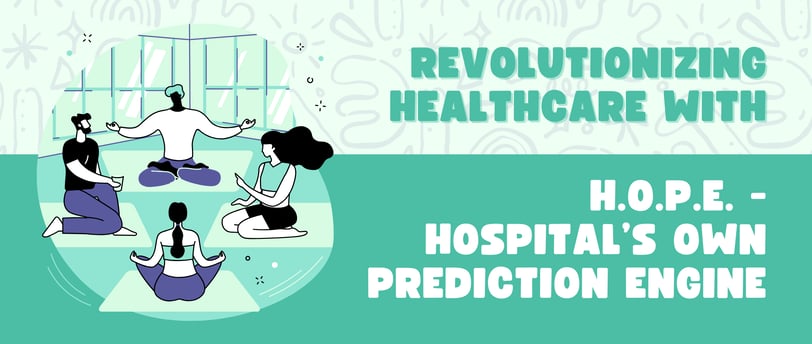Revolutionizing Healthcare with H.O.P.E. : Hospital’s Own Prediction Engine
Chithralekha Rajeev
3/3/20244 min read


In modern healthcare, where the stakes are high and precision is paramount, prescription decisions remain fraught with challenges. The over-reliance on broad-spectrum antibiotics, influenced by comfort, hospital partnerships, or limited access to comprehensive patient data, often leads to long-term complications like antibiotic resistance and adverse side effects. Introducing H.O.P.E. (Hospital’s Own Prediction Engine)—an advanced AI/ML-powered decision-support system that empowers hospitals to harness the full potential of their data for safer, evidence-based prescriptions.
H.O.P.E. isn’t just another tool; it’s a transformative engine that integrates seamlessly with hospital systems to predict the best clinical pathways, personalize treatments, and mitigate risks for patients.
What is H.O.P.E.?
H.O.P.E. is an AI-driven data model that works as a hospital’s proprietary prediction engine, built to analyze vast troves of patient data and historical treatment records. By tapping into existing Electronic Medical Records (EMRs) and other hospital management systems, it provides real-time, actionable insights for doctors. H.O.P.E. is designed to improve prescription accuracy, reduce medication errors, and enable hospitals to make data-driven decisions effortlessly.
Technical Features and Functionality
1. The Data Model
At its core, H.O.P.E. is built on a robust, scalable AI framework:
Data Aggregation: Collects and consolidates data from hospital EMRs, patient treatment histories, and external datasets (e.g., clinical trials, drug efficacy records).
Data Preprocessing: Standardizes data formats, resolves inconsistencies, and handles missing values using advanced imputation techniques.
Feature Engineering: Creates tailored features such as drug efficacy rates, patient demographics, comorbidities, and drug interaction probabilities.
Machine Learning Algorithms:
Supervised learning models, including Random Forest and Gradient Boosting, predict optimal medication pathways.
Unsupervised clustering identifies patterns in patient outcomes for better stratification of treatment risks.
2. Predictive Insights
H.O.P.E. leverages predictive analytics to deliver real-time recommendations:
Risk Identification: Highlights potential adverse effects and contraindications based on patient history.
Alternative Treatments: Suggests safer or more effective medication options by analyzing similar patient profiles.
Long-Term Impact Forecasting: Anticipates outcomes such as antibiotic resistance or weakened immunity from overuse.
3. Seamless Integration
H.O.P.E. is designed to integrate effortlessly into existing hospital ecosystems:
API-Driven Architecture: Ensures real-time data exchange with hospital EMR systems.
Customizable Modules: Adapts to the unique workflows and needs of each hospital.
Data Privacy Compliance: Meets HIPAA, GDPR, and other regulatory standards to ensure patient data security.
Market Opportunity
Market Sizing
Total Addressable Market (TAM): 6,120 hospitals in the U.S., covering a population of 300 million.
Serviceable Addressable Market (SAM): 4,500 medium-care hospitals serving 100+ million people.
Serviceable Obtainable Market (SOM): 1,400 rural hospitals catering to 30 million patients.
The demand for predictive healthcare solutions is rising as hospitals aim to reduce errors, improve efficiency, and enhance patient outcomes.
Revenue Model
H.O.P.E. follows a SaaS-based subscription model with scalability:
Monthly Subscription Fee:
Tiers range from $5,000/month for smaller hospitals to $50,000/month for large healthcare networks.
Customization Charges:
Optional modules for advanced analytics or specialized drug recommendations.
Partnership Opportunities:
Collaborations with pharmaceutical companies to align drug research with real-world clinical data.
Competitive Edge
Unlike generic clinical decision-support tools, H.O.P.E. offers:
Predictive Power: Tailored recommendations based on patient-specific data and outcomes.
Integration-Friendly Design: Minimal disruption to existing hospital workflows.
Scalability: Adaptable to the needs of small clinics and large healthcare systems alike.
Addressing Key Challenges in Healthcare
H.O.P.E. directly tackles some of the most pressing issues in modern medicine:
1. Reducing Errors in Prescriptions
Doctors often rely on experience or standardized protocols, which can lead to suboptimal outcomes. H.O.P.E. ensures that:
Decisions are evidence-based.
Risks of adverse reactions are minimized through detailed analysis of similar cases.
2. Mitigating Antibiotic Resistance
Overprescription of broad-spectrum antibiotics is a leading cause of resistance. H.O.P.E. suggests narrow-spectrum or combination therapies tailored to patient profiles, preserving antibiotic efficacy for future generations.
3. Improving Operational Efficiency
By integrating seamlessly with EMRs and automating data analysis, H.O.P.E. reduces the administrative burden on doctors, enabling them to focus on patient care.
Real-World Impact
Imagine a hospital where:
Doctors have instant access to recommendations based on millions of historical cases.
Medication plans are tailored not just to the condition but also to the individual.
Patients receive safer, faster, and more effective care.
H.O.P.E. makes this vision a reality by:
For Doctors: Delivering real-time, data-backed insights that streamline decision-making.
For Hospitals: Reducing liability risks, improving patient satisfaction, and enhancing operational workflows.
For Patients: Ensuring personalized treatment plans with fewer complications and better outcomes.
The Path Forward
H.O.P.E. is not just a solution for today; it is a platform designed for the future of healthcare. As the system evolves, its capabilities will expand to include:
Wearable Device Integration: Leveraging real-time health metrics for even more precise recommendations.
Genomic Data Analysis: Incorporating genetic information to predict drug efficacy and side effects.
Chronic Disease Management: Extending its scope to manage long-term conditions like diabetes and hypertension.
Conclusion
H.O.P.E. (Hospital’s Own Prediction Engine) represents a leap forward in healthcare innovation. By combining the power of AI with the wealth of data in hospital systems, it provides a foundation for safer, smarter, and more efficient patient care. Its seamless integration, predictive capabilities, and scalable design make it a game-changer for hospitals of all sizes.
In an era where precision medicine is the gold standard, H.O.P.E. is the engine driving healthcare into a future of personalized, data-driven decision-making. It’s more than just a tool; it’s a promise of better care for every patient.
